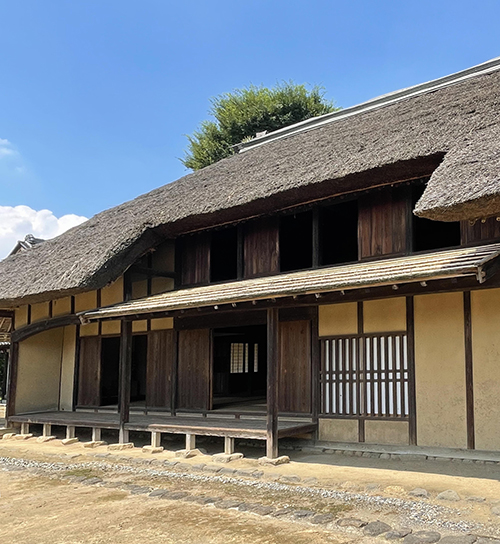

「民藝」運動は日本の建築や生活雑器から民俗を掘り起こし、
そのなかから「用の美」というコンセプトを抽象して
普遍的な列島社会での独自価値感として日本人に刷り込んだ。
わたし自身は自覚的にこの運動について興味を持ったことはないけれど、
北海道発の住宅革新である高断熱高気密技術の南下趨勢と同時に
取材などで本州地域を探訪する中で、ルーツとしての古民家に自然と親しみ
その体験から、よき住宅の道標として重ね合わせるようになった。
結果として日本各地の古民家群を巡り歩くうちに
各所でユニークで保存対象とされる住宅を探訪すると
訪問先対象がだんだんと「民藝」視点と重なり合うことに気付かされる。
考えると古民家の保存そのものも民藝運動のひとつの社会成果なのかも知れない。
数年前に、東京駒場の日本民藝館も探訪して学ばせても頂いた。
ただ現状では民藝認定は津軽海峡で断絶し、北海道は無視されてきた。
数年前からアイヌ民俗が北海道の「民藝」と追認されそうな雰囲気。
この点はさて、どうだろうか? それはそれであって
高断熱高気密こそが現代的「民藝」と思う立場からはやや疑問も。
群馬県大室公園に移設の古民家・関根家は民俗に深い洞察を持った建築学者
今和次郎<1888-1973年>がその「用の美」に感嘆した古民家だという。
草葺屋根の桁行平部分(前面)中央を四角く切り落とした形態のこの民家を見て
「今回の調査に依って民家にひとつの新型を発見した。『赤城型』と称すべきか」
と述べたことが住居形式分類名の由来とされている。
地元の人々の呼び方は以下のようなものが一般的だった。
「キリアゲニケエ・キリオトシニケエ・キリアゲセガイ・アナヒサシ」
ニケエというのは、想像の通り「2階」が方言風に表現されたもの。
こっちの呼び名の方がはるかに響いてくるが、学者としては赤城型としたものか。
いずれにしても2階の「養蚕空間」という生業の場が主役で
生糸という地域の代表的産品の現場空気感が強く感じられる。
明治時代に至り養蚕は隆盛期を迎え良質の生糸を大量に輸出した。
養蚕業・絹糸は「外貨獲得産業」として重視され日本の近代化の礎を築いた。
今和次郎も「養蚕や人々の営みが、住まい方や建物の造形に及ぼす影響、
如何に係わるかが興味の対象」であったと記録されている。
<1998年10月の前橋市指定重要文化財「旧関根家住宅」見学会資料より>

今和次郎氏のコトバにまったく同意であります。
それこそ用が求めるカタチに自然にしたがって、
淡々とプロポーションが研ぎ澄まされた。そういう印象が非常に深い。
この開放された2階空間で蚕たちが無心にクワの葉を食んで
地域の産業を大きく根付かせた。凜とした誇りを感じる。
<2番目の写真は宮内庁から公開の天皇ご一家の「養蚕」作業>
English version⬇
[The “use” of manufacturing Kiriagenikee “Akagi type” sericultural folk houses – 2
A view of the house as a folk custom. The “use” of the local economy and production activities of daily life is reflected in the design and the proportions are sharpened. …
The “Mingei” movement is a movement to abstract the concept of “beauty of use” from the folklore of Japanese architecture and daily utensils.
and abstracted the concept of “beauty of use” from them
The Mingei movement has imprinted the concept of “beauty of use” as a universal, unique value in the archipelago society on the Japanese people.
Although I myself have never been consciously interested in this movement
I have not been consciously interested in this movement myself, but I have been exploring the Honshu region for news gathering and other purposes.
I have been exploring the Honshu region for news gathering and other purposes, and have naturally become familiar with the old private house as a root of the movement.
Through this experience, I have come to see them as a guidepost for good housing.
As a result, as I traveled around Japan visiting old private houses in various parts of the country
As I explored the unique houses in each area, which are considered to be the object of preservation
I gradually realized that the objects I was visiting gradually overlapped with the “Mingei” point of view.
Considering this, the preservation of old private homes itself may be one of the social achievements of the Mingei movement.
A few years ago, I also visited the Japan Folk Art Museum in Komaba, Tokyo, to learn more.
However, the current situation is that the recognition of mingei has been cut off at the Tsugaru Strait, and Hokkaido has been neglected.
However, it has been several years since Ainu folklore was recognized as Hokkaido’s “folk art.
Well, what do you think about this point? It is what it is.
From the standpoint that highly insulated and airtight houses are the modern “folk art,” there are some doubts.
The Sekine House, an old private house relocated to Omuro Park in Gunma Prefecture, is said to be an old private house that architectural scholar
Wajiro Kon (1888-1973), an architect with deep insight into folklore, admired the “beauty of use” of this old private house.
He said, “This house has a thatched roof with a square cut off in the center of the front part of the girder.
He said, “This research has led me to discover a new type of minka. I think it should be called the Akagi type.
This is said to be the origin of the name of the house type classification.
The local people commonly referred to it as follows.
Kiriage-nikee, kiriotoshi-nikee, kiriage-segai, anahisashi.”
Nikee, as you can imagine, is a dialectal rendering of “second floor.
This name is much more resonant, but as a scholar, I guess it is the Akagi type.
In any case, the “sericultural space” on the second floor plays a leading role.
The atmosphere of the site of raw silk, a representative product of the region, is strongly felt.
In the Meiji period (1868-1912), sericultural industry flourished and exported large quantities of high-quality raw silk.
Sericultural industry and silk yarn were emphasized as “foreign currency earning industry” and laid the foundation of Japan’s modernization.
Wajiro Kon also wrote, “I am interested in the influence of sericulture and people’s activities on the way of living and the form of buildings, and how they are related to each other.
He was also interested in how sericulture and people’s activities affected the way they lived and the shape of buildings.
<(From the materials of the tour of the former Sekine Residence, an Important Cultural Property designated by Maebashi City in October 1998.
I completely agree with Mr. Kon Wajiro’s words.
The proportions of the building were created according to the shape that the use demanded.
The proportions have been sharpened in an unobtrusive manner. I have a very deep impression of this.
In this open space on the second floor, silkworms are eating mulberry leaves without thinking.
the local industry took root in a big way. But I feel a sense of pride in this place.
.
Posted on 8月 19th, 2022 by 三木 奎吾
Filed under: 住宅マーケティング, 日本社会・文化研究







コメントを投稿
「※誹謗中傷や、悪意のある書き込み、営利目的などのコメントを防ぐために、投稿された全てのコメントは一時的に保留されますのでご了承ください。」
You must be logged in to post a comment.